Detailed airport guide Connection between international flights
This page provides information on how to connect between international flights without collecting your baggage or entering Japan. Please check with your airline before departing to ensure that you are able to use this method to make a connection.

Table of Contents
1.undergo security screening after arrival, 2.go to the departure terminal, 3.connection procedure, 4.points to note when connecting flights overnight, 5.going outside the airport during your waiting time, 6.while waiting for your connecting flight.
Due to the difference in security screening criteria between Japan and other countries, passengers who have already been screened in the country of departure will be required to undergo screening again when transiting in Japan except for some cases.
After getting off the airplane, proceed by following the "International Connecting Flights" guide sign. To prevent hijacking and other hazards, baggage inspection and body check are conducted.
For more information, please refer to the following article.
For the peace of mind of all passengers, we request you to undergo security screening of yourself and your carry-on baggage. Here is an explanation on security screening procedures.
If the terminal you arrived at is not the terminal you will depart from, please use a shuttle bus to travel between terminals.
Terminals for arrivals and departures differ from airline to airline. Please check at the following in advance.
You can check the terminals for the arrival and departure on the date of flight on the flight information page
Passengers arriving at Terminal 1
Shuttle buses are available at Bus Gates No. 28 and No. 59 to get to Terminal 2 (T2) and Terminal 3 (T3).
Traveling time
- T1→T2: Approx. 8 to 12 minutes
- T1→T3: Approx. 12 to 16 minutes
Please refer to the following timetables for bus operation times.
- Timetable for Bus Gate No. 28(PDF:542.66 KB)
- Timetable for Bus Gate No. 59(PDF:536.58 KB)
* Please be aware that shuttle buses to Terminal 3 only operate at certain times.
* Please note that you can't take a shuttle bus if you will be connecting to AERO K AIRLINES, Philippines AirAsia, SPRING JAPAN, or SPRING AIRLINES at Terminal 3. You need to proceed to arrival process at Terminal 1 and then move to Terminal 3 for your check-in.
You can search the location of the bus gate for the shuttle bus on the map.
Passengers arriving at Terminal 2
Shuttle buses are available at Bus Gates No. 70 and No. 80 to get to Terminal 1 (T1).
Shuttle buses are available at Bus Gate No. 70 to get to Terminal 3 (T3).
- T2→T1: Approx. 12 to 16 minutes
- T2→T3: Approx. 4 minutes
- Timetable for Bus Gate No. 70(PDF:534.19 KB)
- Timetable for Bus Gate No. 80(PDF:39.33 KB)
* Please note that you can't take a shuttle bus if you will be connecting to AERO K AIRLINES, Philippines AirAsia, SPRING JAPAN, or SPRING AIRLINES at Terminal 3. You need to proceed to arrival process at Terminal 2 and then move to Terminal 3 for your check-in.
Passengers arriving at Terminal 3
Shuttle buses are available at the international connection bus gate to get to Terminal 1 (T1) and Terminal 2 (T2).
- T3→T1: Approx. 24 to 28 minutes
- T3→T2: Approx. 12 minutes
When you get to the departure terminal, please undergo the connection procedure.
Check your flight time and boarding gate on your boarding pass or a flight information board. Follow the directions to the boarding gate shown on the terminal displays. Please make sure you arrive at the boarding gate well in advance of the boarding announcement time. Be aware that sudden changes can occur and pay attention to announcements and check flight information displays.
* If you do not have a boarding pass, please contact the airline of your connecting flight.
You can check the latest flight information on the flight information page.
Aircraft can only operate between 06:00AM and 12:00AM at Narita Airport. Passengers cannot remain in the passenger terminals on the airside (before arrival procedures and after departure procedures) outside of those times.
Passengers transiting overnight must complete arrival immigration and customs procedures. Some passengers may need a visa at that time. If you are in unsure about this, please contact your airline or the Immigration Services Agency of Japan directly in advance
When connecting between international flights, passengers are not required to undergo immigration procedures if they are staying in the departure area (airside) until their next flight.
However, immigration procedures will be required if passengers wish to leave this area to meet a friend or to go outside the airport. In some cases, a visa may also be required. Please contact your airline or the Immigration Services Agency of Japan directly in advance, if you are unsure of the requirements.
We recommend the following services to passengers who wish to take a rest or go shopping.
Various other facilities and services are available. Check the following for further information.
We’re sorry, this site is currently experiencing technical difficulties. Please try again in a few moments. Exception: request blocked

Entering Japan: Guide to Airport Arrival and Departure Procedures in Japan
- Written by: Miyu Shimada
When entering Japan, the first step after landing at the airport is getting through customs and immigration. Foreign visitors are required to complete various procedures upon arrival. Since the spread of Covid-19 in 2020, following procedures and rules is extremely important to ensure a safe trip! Here we will introduce what you need to prepare before a trip as well as entry procedures as of November 2022. Main image: PIXTA
From arrival to entry
Departure to arriving back home, baggage delivery services at the airport, getting to and from the airport, checking for arrival procedure updates.
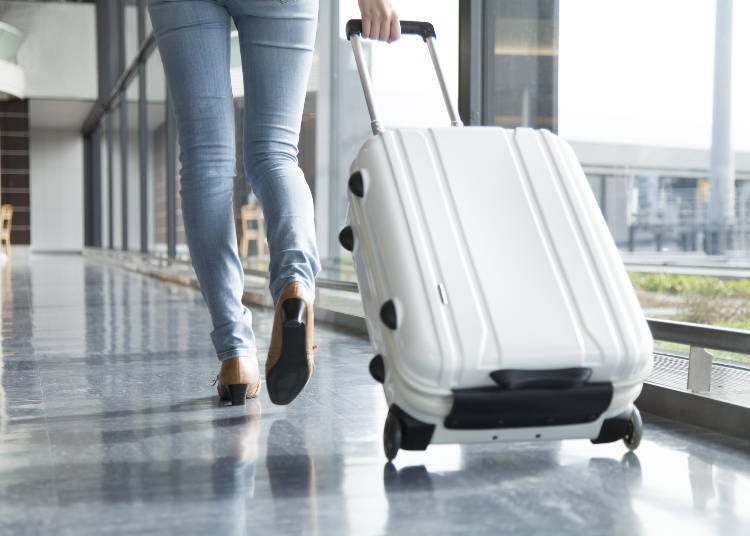
Once you arrive in Japan and get off the plane, the process generally goes as follows: ・medical inspection at the quarantine station, ・immigration, ・claiming your bags, ・inspections at the plant and animal quarantine station, ・customs, and ・heading to the arrival lobby (the order may vary depending on the airport ). Here, we will give a step-by-step guide to arrival procedures and the documents you need to prepare.
Step 1: What to prepare before leaving your country and once you arrive in Japan
(1) Check Travel Requirements Before Your Flight and Upon Arrival Currently, Japan’s arrival and departure procedures vary from country to country. Make sure to check beforehand whether you need a visa and whether your passport is valid throughout the duration of your stay. Please also remember that procedures change regularly and can do so just before your travels. It’s essential to keep up to date with the latest information and the arrival/departure procedures for your country. Also, make sure to regularly check for updates on the official sites of embassies and consulates in Japan regarding vaccination certificates, test certificates, quarantining, and more. You can see your country’s embassy website under the “ Find an embassy ” section here. (2) Pre-register for the Visit Japan Web Service The Visit Japan Web Service enables you to complete immigration procedures and customs declarations online. The service is available to both foreign visitors and Japanese nationals returning from abroad. What’s more, the Fast Track feature is also added to this service. Fast Track allows users to complete some quarantine procedures (registering documents such as vaccination certificates, a Covid-19 Negative Test Result Certificate issued within 72 hours prior to departure, and questionnaires) in advance. The Japanese government has asked visitors to cooperate in using this service and feature. Please register before your travels to ensure that all procedures go smoothly! Available airports (as of November 1, 2022): ・ Narita International Airport ・ Haneda Airport ・Kansai International Airport ・Central Japan International Airport ・ Fukuoka Airport ・New Chitose Airport ・Naha Airport
*Note: From November 1, 2022, the Visit Japan Web Service replaced the health and location monitoring app MySOS (registration for the “MySOS Web” service can be done online).
Step 2: Quarantine station
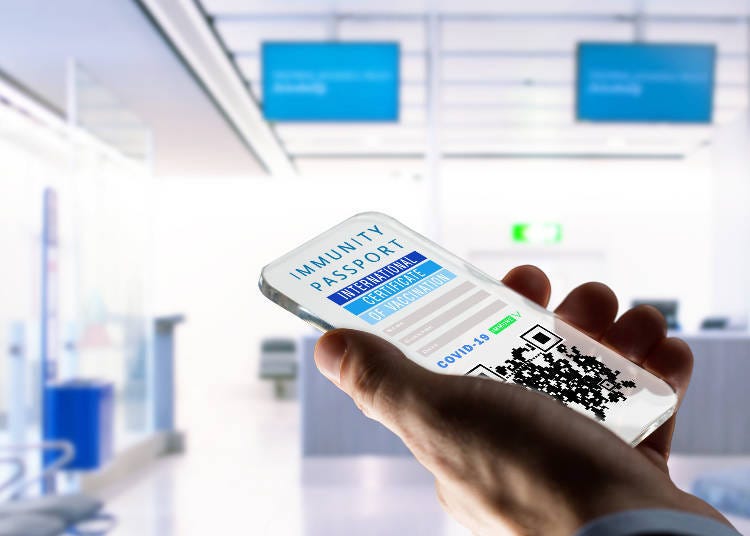
(1) Covid-19: Current Border Measures As of November 2022, all returnees and entrants to Japan are required to submit either a valid COVID-19 vaccination certificate (3 doses) that shows you’ve either gotten a vaccination on the Emergency Use List released by the World Health Organization (WHO) or a Covid-19 Negative Test Result Certificate issued within 72 hours before departure. Please make sure to prepare the documents in advance. If you cannot submit either, you won’t be allowed entry into Japan.
- Valid vaccination certificate showing that the applicant has been vaccinated three times (must meet the following conditions) https://www.mhlw.go.jp/stf/covid-19/border_vaccine.html
- If you don’t have a valid vaccination certificate, you must have a Covid-19 Negative Test Result Certificate (test taken prior to departure).
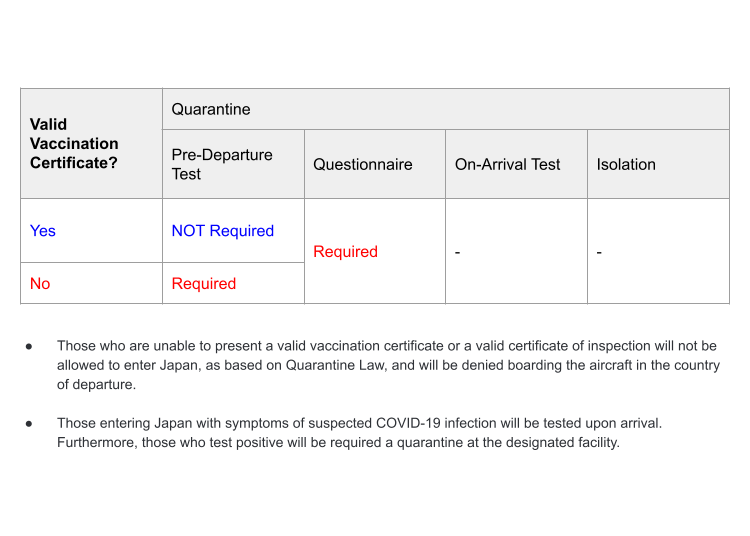
You need to submit the following documents to enter Japan. Please use Fast Track and the Visit Japan Web Service mentioned above to ensure a smooth process.
- Vaccination certificate or a Covid-19 Negative Test Result Certificate issued within 72 hours prior to departure
- Questionnaire For those who can't use Fast Track, fill out the questionnaire online , save the QR code via screenshot or printed copy, and present it at the quarantine station
Japan’s border control measures, which were strengthened due to the spread of Covid-19, have been drastically eased since October 11, 2022. Covid-19 tests upon arrival are no longer required. Moreover, visitors don’t have to quarantine at home or at an accommodation facility, and they also don’t have to adhere to follow-ups (e.g. reporting on health condition, etc.). In addition to this, visitors can now use public transportation from the airport . (2) Covid-19 Testing Upon Arrival to Japan When arriving in Japan, you won’t be asked to get tested, but your temperature will be taken. You'll be tested at the quarantine station if you appear to have any Covid-19 symptoms. Visitors who test positive upon arrival will be taken to a facility designated by the quarantine station for medical treatment or, depending on their condition, hospitalized. Please make sure to follow the instructions of the quarantine officer.
Step 3: Immigration
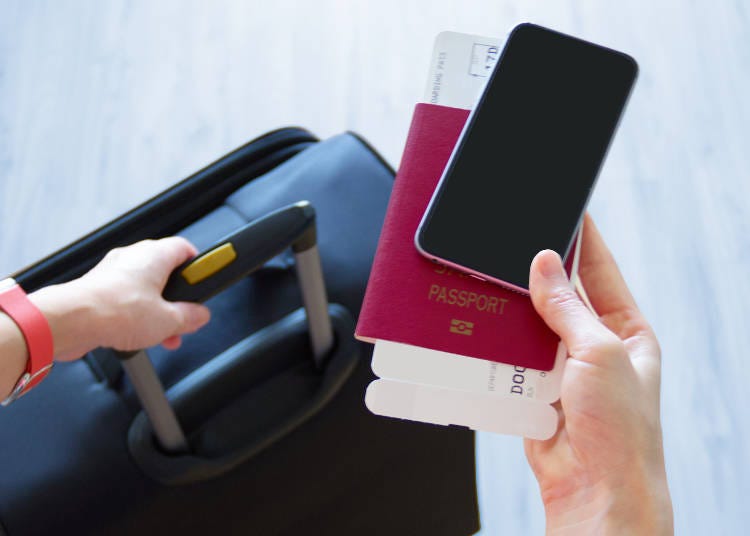
The following documents must be submitted at immigration.
- Disembarkation card (There’s also the option of an ED card-a special re-entry disembarkation/embarkation card)
- Visa (only if necessary)
The quarantine station is divided into resident and non-resident areas. At the counter, submit the documents listed above, and state your purpose of entry, your destination, and the duration of your visit.
Step 4: Plant and animal quarantine station/customs
(1) Plant and Animal Quarantine Station At the Plant and animal quarantine station, animals, plants, and food brought from abroad are checked for infectious diseases, pests, and harmful substances. There are rules and restrictions on the plants and foods that can be brought into Japan, some even being prohibited. Bringing anything illegal can lead to a fine or imprisonment, so check whether the items you wish to bring are approved by the quarantine station. Examples of items that are prohibited from being brought into Japan ・Fake or counterfeit brand goods ・Meat products, animal products ・Illegal drugs ・CITES (the Convention on International Trade in Endangered Species of Wild Fauna and Flora) species

(2) Submit a Declaration of Personal Effects and Unaccompanied Articles at Customs Customs inspections check to ensure that no prohibited or restricted items are being brought into Japan, that you don’t have cash that must be declared, and that your belongings are within the duty-free range. Anyone entering Japan is required to submit a Declaration of Personal Effects and Unaccompanied Articles form. The declaration form is available on the plane or at the customs checkpoint at the airport . This form should be filled out and submitted.
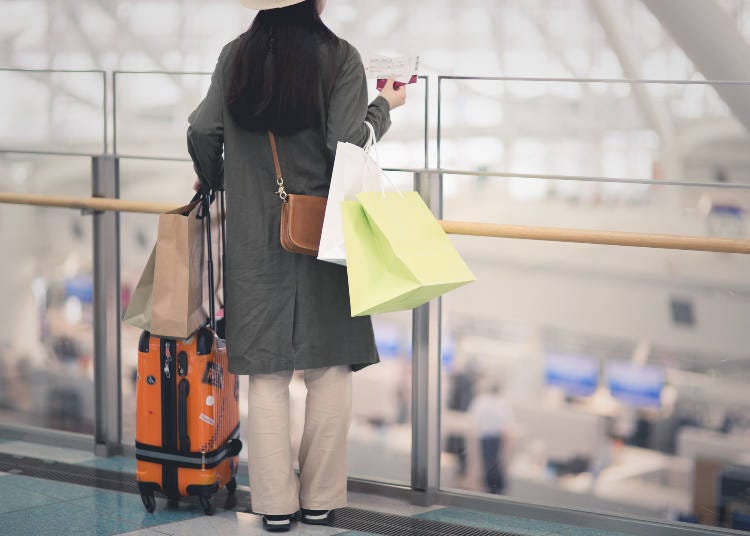
Departure procedures consist of: checking in at the airport , going through security checks, customs inspections, immigration, and taking your flight back.
Step 1: What to prepare before you leave Japan
Check the Arrival Procedures in Your Country Before Leaving Japan Rules, criteria, and required documents for departures and arrivals may change suddenly and differ from country to country. Currently, most countries do not require a Covid-19 test before departure, but this is subject to change. Even if you’ve checked the procedures in your country before your trip, recheck them for updates when you leave Japan. Please make sure to double-check at least the following:
- Whether or not you need a vaccine certificate (a paper or digital document)
- Whether or not a Covid-19 Negative Test Result Certificate is required (expiration periods, testing method, and other criteria differ from country to country, so please be sure to check beforehand).
Covid-19 Negative Test Result Certificates in Japan can be issued at health facilities that offer testing or at testing stations located within airports. Please note that some health facilities only fit the criteria for specific countries. Furthermore, some countries might have designated health facilities you must go to.
Step 2: Checking-in at the airport
You can check in at your airline’s check-in counter (some are unattended) and complete the baggage check-in procedures. There are strict rules regarding carry-on baggage, so be sure to check them in advance and be prepared to check in any items you can’t bring on board. For liquids, each passenger is limited to one 100-milliliter container that must fit in a one-liter, clear plastic bag.
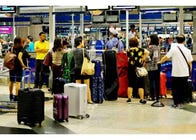
Step 3: From security checks to immigration
First, go to the security check and have your baggage inspected. Then, proceed to customs and immigration. If you have any duty-free items, present your passport and the things you’ve purchased to the customs officers. The more duty-free goods you have, the longer it takes to inspect. Please keep this in mind, and get to customs as early as possible.
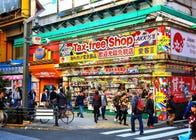
Baggage delivery services are available at the airport ! Upon arrival, and depending on the time, it’s possible to have your baggage delivered from the airport to your accommodation the day of! When sending your luggage, it’s important to confirm whether your accommodation will be able to receive it. You can also send baggage from your accommodation to the airport before leaving Japan! This is very convenient if you want to go to the airport without carrying large and heavy suitcases with you. The time it takes for your baggage to reach the airport depends on the delivery company. Also, we recommend checking the pick-up times that are adjustable according to the time of your flight.
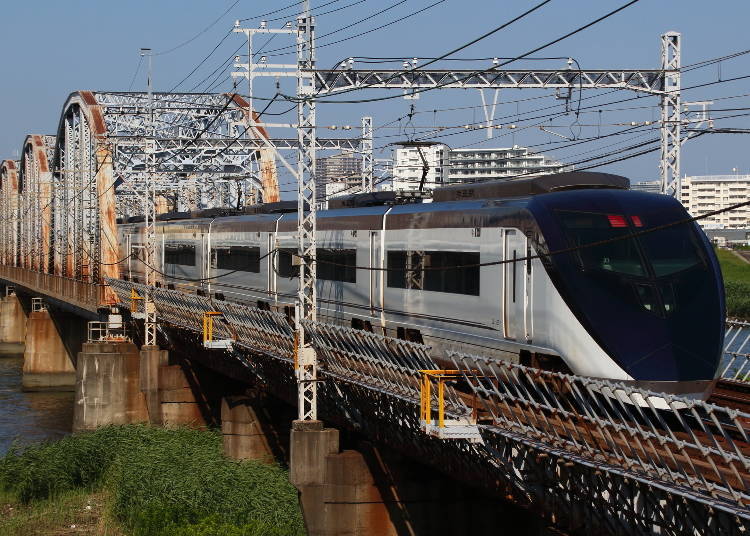
Below is a list of some convenient transportation options at major airports in Japan.
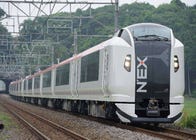
Airport arrival and departure procedures and requirements are subject to change without prior notice. Please check the official websites of embassies, consulates, and other agencies before your trip to familiarize yourself with the procedures in your country and in Japan. *The information in this article from November 2022. Please check official websites for the latest information.

Miyu is a travel writer and tour conductor with over a decade of experience in developing educational content for working individuals. She has a passion for exploring new cultures and has visited more than 150 cities in around 50 countries. Her goal is to sample great food, experience nature, enjoy historical sites, and bathe in hot springs around the world. Miyu left her corporate job to pursue her passion for travel and now spends over 100 days a year abroad while working as a writer. She promotes the joy of travel, the beauty of Japan, and the diverse cultures of the world by traveling to different parts of Japan and collaborating with inbound tour operators and fellow travel writers.
- Category Airport
- How To: Customs Procedures and Regulations
Share this article.

Recommended places for you

Jukuseiniku-to Namamottsuarera Nikubaru Italian Nikutaria Sannomiya
Kobe, Sannomiya, Kitano

Rukku and Uohei
Sapporo / Chitose

Asahiyama Zoo
Zoos, Aquariums & Botanical Gardens

Yoshida Gennojo-Roho Kyoto Buddhist Altars
Nijo Castle, Kyoto Imperial Palace

Kamesushi Sohonten
Umeda, Osaka Station, Kitashinchi

ISHIDAYA Hanare

BicCamera Coupon! Tax-free, Plus Discount!

Top Tips for Tourists! Roppongi Project for Safety and Peace of Mind: Creating a Fun and Safe Roppongi for All

[Taste Test!] A New Product in the Popular 'Pikachu Tokyo Banana' Series! Adorable Special Cans Now Available

The Samurai Restaurant: An Insane, Energetic Night of Music and Lights
by: Cassandra Lord

5 Quirky Japanese Summer Festivals You Must See: Dancing, Fire, Bellybuttons & More!
by: Miyu Shimada

Top 10 Must-Visit Aquariums in Tokyo & Nearby Areas

Find the Best Transport from New Chitose Airport to Sapporo

Sendai Airport (SDJ) Guide: Services, Must-Visit Spots, Food, Shopping, and Nearby Hotels

Sendai Airport Access Guide: Getting to Tohoku's Tourist Attractions By Train, Bus, and More

Japan Relaxes its Multiple-Entry Visa Requirements for Filipinos: What you need to know

Fine Japanese Dining in Kyoto! Top 3 Japanese Restaurants in Kiyamachi and Pontocho Geisha Districts

Guide to Tokyo's Old Quarter: 7 Quaint Spots in Yanesen!
- #best sushi japan
- #what to do in odaiba
- #what to bring to japan
- #new years in tokyo
- #best ramen japan
- #what to buy in ameyoko
- #japanese nail trends
- #things to do japan
- #onsen tattoo friendly tokyo
- #best coffee japan
- #best japanese soft drinks
- #best yakiniku japan
- #japanese fashion culture
- #japanese convenience store snacks
Security Alert May 17, 2024
Worldwide caution.
- Travel Advisories |
- Contact Us |
- MyTravelGov |
Find U.S. Embassies & Consulates
Travel.state.gov, congressional liaison, special issuance agency, u.s. passports, international travel, intercountry adoption, international parental child abduction, records and authentications, popular links, travel advisories, mytravelgov, stay connected, legal resources, legal information, info for u.s. law enforcement, replace or certify documents.
Before You Go
Learn About Your Destination
While Abroad
Emergencies
Share this page:
Travel Advisory January 8, 2024
Japan - level 1: exercise normal precautions.
Japan – Level 1: Exercise Normal Precautions
Reissued after periodic review without changes.
Exercise normal precautions in Japan.
Read the country information page for additional information on travel to Japan.
If you decide to travel to Japan:
- Enroll in the Smart Traveler Enrollment Program (STEP) to receive Alerts and make it easier to locate you in an emergency.
- Follow the Department of State on Facebook and Twitter .
- Follow Embassy Tokyo’s American Citizen Services section on Facebook and Twitter .
- Review the Country Security Report for Japan.
- Visit the CDC page for the latest Travel Health Information related to your travel.
- Prepare a contingency plan for emergency situations. Review the Traveler’s Checklist .
Embassy Messages
View Alerts and Messages Archive
Quick Facts
Duration of intended period of stay. Please note you cannot travel on a passport you have previously declared as lost or stolen even if you subsequently locate it
One page required for entry stamp
Amounts equivalent to ¥1,000,000 or above subject to declaration
Embassies and Consulates
U.S. Embassy Tokyo 1-10-5 Akasaka, Minato-ku, Tokyo 107-8420 Japan Telephone: 81-3-3224-5000 Emergency After-Hours Telephone: 81-3-3224-5000 Fax: 81-3-3224-5856 Our Navigator Assistant will guide you to the information you need.
U.S. Consulate General Osaka-Kobe 2-11-5, Nishitenma, Kita-ku, Osaka 530-8543, Japan Telephone: 81-6-6315-5900 Emergency After-Hours Telephone: 81-3-3224-5000 Fax: 81-6-6315-5914 Our Navigator Assistant will guide you to the information you need.
U.S. Consulate General Naha 2-1-1 Toyama, Urasoe City, Okinawa, Japan Telephone: 81-98-876-4211 Emergency Telephone: 81-3-3224-5000 Fax: 81-98-876-4243 Our Navigator Assistant will guide you to the information you need.
U.S. Consulate General Sapporo Kita 1-jo Nishi 28-chome, Chuo-ku, Sapporo 064-0821, Japan Telephone: 81-11-641-1115 Emergency After-Hours Telephone: 81-11-641-1115 Fax: 81-11-643-1283 Our Navigator Assistant will guide you to the information you need. All assistance at the Consulate General Sapporo is by appointment only.
U.S. Consulate Fukuoka 5-26 Ohori 2-chome, Chuo-ku, Fukuoka 810-0052, Japan Telephone: 81-92-751-9331 Emergency After-Hours Telephone: 81-3-3224-5000 Fax: 81-92-713-9222 [email protected] Our Navigator Assistant will guide you to the information you need. Routine services are provided by appointment only.
U.S. Consulate Nagoya Nagoya International Center Bldg. 6th floor, 1-47-1 Nagono, Nakamura-ku, Nagoya 450-0001, Japan Telephone: 81-52-581-4501 Emergency After-Hours Telephone: 81-3-3224-5000 Fax: 81-52-581-3190 Our Navigator Assistant will guide you to the information you need. Emergency services are provided by U.S. Consulate General Osaka-Kobe.
Destination Description
See the Department of State’s Fact Sheet on Japan for information on U.S-Japan relations.
Entry, Exit and Visa Requirements
Visit the Embassy of Japan website for the most current visa information.
There are no COVID-related entry requirements for U.S. citizens.
Entry & Exit:
- You must have a valid passport and an onward/return ticket for tourist/business "visa free" stays of up to 90 days. Your passport must be valid for the entire time you are staying in Japan.
- You cannot work on a 90-day "visa free" entry.
- "Visa free" entry status may not be changed to another visa status without departing and then re-entering Japan with the appropriate visa, such as a spouse, work, or study visa.
- Visit the Embassy of Japan website for the most current information on all visa categories.
- Japanese immigration officers may deny you entry if you appear to have no visible means of support.
- All foreign nationals are required to provide fingerprint scans and to be photographed at the port of entry. Exceptions to this requirement include diplomatic and official visa holders, minors, and individuals covered under SOFA Article IX.2. For further information about landing procedures, please visit the Immigration Bureau of Japan’s website .
- Make sure your passport is valid. Note you cannot travel on a passport you have previously declared as lost or stolen even if you subsequently locate it. Japanese authorities will likely deny you entry into Japan if you attempt to do so. If you have reported your passport lost or stolen, you must apply for a new passport before travel.
Transiting Japan:
- Ensure that your passport and visa are valid and up-to-date before you leave the United States. Passport services are not available at the airport.
- Airlines in Japan may deny you boarding for transit if you do not have the required travel documents for an onward destination in another country or if your passport does not have six months of validity remaining. For the entry requirements of the country you are traveling to, visit the State Department's Country Specific Information website.
Military/SOFA Travelers: While active-duty U.S. military personnel may enter Japan under the Status of Forces Agreement (SOFA) with proper Department of Defense (DoD) identification and travel orders, all SOFA family members, civilian employees, and contractors must have valid passports to enter Japan. Please consult the DOD Foreign Clearance Guide before leaving the United States.
See the Immigration Bureau of Japan’s website for various immigration procedures.
HIV/AIDS Restrictions: The U.S. Department of State is unaware of any HIV/AIDS entry restrictions for visitors to or foreign residents of Japan.
Find information on dual nationality , prevention of international child abduction and customs regulations on our websites.
Safety and Security
For police services in Japan, dial 110. For fire or ambulance services, dial 119.
Crime: Crime against U.S. citizens in Japan is generally low and usually involves personal disputes, theft, or vandalism. In addition:
- Robberies committed after a victim has been drugged from a spiked drink can occur, especially in nightlife districts.
- Sexual assaults are not often reported, but they do occur, and victims may be randomly targeted. Victim's assistance resources or shelters are difficult for foreigners to access.
- Hate-related violent crimes rarely occur, although some U.S. citizens have reported being the target of discrimination because of their nationality or their race.
- Pick pocketing can occur in crowded shopping areas, on trains, and at airports.
- Police reports must be filed before leaving Japan, as Japanese police will not accept reports filed from overseas.
- In instances involving credit card theft or fraud, Japanese police often provide a report number rather than a police report. You can provide this report number to your credit card company to confirm the incident with the police.
Entertainment and Nightlife Districts in Tokyo:
- Exercise caution in all entertainment and nightlife districts throughout Japan, especially Roppongi, Kabuki-cho, Shibuya, and Ikebukuro.
- Incidents involving U.S. citizens in these areas include physical and sexual assaults, drug overdoses, theft of purses, wallets, cash and credit cards at bars or clubs, and drugs slipped into drinks.
- Drink spiking at bars and entertainment venues, especially in areas such as Roppongi and Kabuki-cho, near Shinjuku, has led to robbery, physical and sexual assaults, and credit card fraud. Some victims regain consciousness in the bar or club; other victims may awaken on the street or other unfamiliar locations.
- U.S. citizens have reported being threatened with gun or knife violence in such venues so that they will pay exorbitant bar tabs or withdraw money. U.S. citizens have also reported being beaten when they have refused to pay or hand over money.
- There have been reports of U.S. citizens being forcibly taken to ATMs and robbed, or made to withdraw funds after being unable to pay exorbitant bar tabs.
- Please be aware that Roppongi, Kabuki-cho, and other entertainment and nightlife districts have also been the scenes of violence between criminal syndicates.
See the Department of State and the FBI pages for information on scams.
Police reports must be filed at the nearest police station prior to departure from Japan. The Japanese police cannot accept reports filed from overseas. Report crimes to the local police at 110 and contact the U.S. Embassy at 03-3224-5000 (011-81-3-3224-5000 from overseas). Remember that local authorities are responsible for investigating and prosecuting the crime.
See our webpage on help for U.S. victims of crime overseas .
- help you find appropriate medical care;
- assist you in reporting a crime to the police;
- contact relatives or friends with your written consent;
- explain the local criminal justice process in general terms;
- provide a list of local attorneys;
- provide information on victim’s compensation programs in the U.S. ;
- provide an emergency loan for repatriation to the United States and/or limited medical support in cases of destitution
- help you find accommodation and arrange flights home; and/or
- replace a stolen or lost passport.
Contacting Police, Fire and Ambulance Services: You can reach the police throughout Japan by dialing 110. Fire and ambulance services can be contacted by dialing 119. Note that English-speaking dispatchers may not be available. Please review advice on “Calling for Help” on our website . If you need assistance, you should be able to describe your address/location in Japanese or find someone who can do so, since few police officers speak English.
Domestic Violence: Victim's assistance resources or battered women's shelters exist in major urban areas, but are difficult for foreigners to access. These types of resources are also generally unavailable in rural areas. Investigations of sexual assault crimes are often conducted without female police officers present, and police typically ask about the victim's sexual history and previous relationships.
Tourism: The Victim's assistance resources or battered women's shelters exist in major urban areas, but are difficult for foreigners to access. These types of resources are also generally unavailable in rural areas. Investigations of sexual assault crimes are often conducted without female police officers present, and police typically ask about the victim's sexual history and previous relationships.
See our webpage for more information on insurance providers for overseas coverage.
Local Laws & Special Circumstances
Criminal Penalties: You are subject to Japanese law while you are in Japan. If you violate Japanese laws, even unknowingly, you may be arrested, imprisoned, or deported. If you are arrested in Japan, even for a minor offense , you may be held in detention without bail for several months or more during the investigation and legal proceedings.
Some offences are also prosecutable in the United States, regardless of Japanese law. For examples, see our website on crimes against minors abroad and the Department of Justice website.
The vast majority of arrests of U.S. citizens in Japan are for drug-related offenses. Japanese authorities aggressively pursue drug smugglers and users, including recreational users with sophisticated detection equipment, "sniffing" dogs, blood tests, “stop and frisk” tactics, and other methods. Penalties for possessing, using, or trafficking a drug that is illegal in Japan are severe, and convicted offenders can expect long jail sentences and fines. Please note that some drugs which may be legal in certain jurisdictions outside of Japan, including marijuana and synthetic drugs, remain illegal in Japan. This also applies to certain prescription drugs that doctors in the United States may prescribe. Japanese law makes no distinction between medical and recreational marijuana; therefore, having a prescription for medical marijuana will not help you avoid arrest or prosecution. Even possession of a small amount of marijuana for personal medical or recreational use can result in a long jail sentence and fine. Japanese customs officials carefully screen incoming packages, and individuals who are mailed drugs can be arrested and prosecuted as drug traffickers.
Confiscation of Prescription Drugs and Other Medication: It is important to note that some medications that are routinely prescribed in the United States, including Adderall and marijuana, are strictly prohibited in Japan. The Japanese government decides which medications may be imported legally into Japan. The Embassy and Consulates of Japan in the United States have limited information available and do not have a comprehensive list of specific medications or ingredients. Please see more information on importing medicines into Japan.
You must carry your U.S. passport or Japanese Residence Card (Zairyu Kado) with you at all times. In Japan, you may be taken in for questioning if you do not have your passport or Japanese residence card to show your identity and status in Japan (e.g., as a visitor, student, worker, or permanent resident).
It is illegal to work in Japan while in tourist or visa-waiver status. Overstaying your visa or working illegally may lead to fines of several thousands of dollars, and in some cases, re-entry bans as long as 10 years, or indefinitely for drug offenders. For additional information, please see Japan’s Immigration Control and Refugee Recognition Act and contact the Japanese Embassy or nearest Japanese Consulate in the United States for more information.
Driving under the influence of alcohol could also land you immediately in jail. The blood-alcohol limit in Japan is 0.03%. Punishments can be up to 10,000 USD in fines and up to five years in prison.
Possession of a gun or ammunition is a crime in Japan. Carrying a knife with a locking blade, or a folding blade that is longer than 5.5 cm (a little more than two inches), is illegal in Japan. U.S. citizens and U.S. military personnel have been arrested and detained for more than 10 days for carrying pocket knives that are legal in the United States but illegal in Japan. The possession of lock-picking tools is illegal in Japan.
Establishing a Business : Individuals establishing a business or practicing a profession that requires additional permits or licensing should seek information from the competent local authorities, prior to practicing or operating a business.
A list of English-speaking lawyers located throughout Japan is available on our website .
Arrest Notification : If you are arrested or detained, ask police or prison officials to notify the U.S. Embassy immediately. See the Department of State’s webpage and the Embassy’s website for additional information.
Counterfeit and Pirated Goods: Although counterfeit and pirated goods are prevalent in many countries, they may still be illegal according to local laws. You may also pay fines or have to give them up if you bring them back to the United States. See the U.S. Department of Justice’s website for more information .
Faith-Based Travelers: See our following webpages for details:
- Faith-Based Travel Information
- International Religious Freedom Report – see country reports
- Human Rights Report – see country reports
- Hajj Fact Sheet for Travelers
- Best Practices for Volunteering Abroad
LGBTQI+ Travelers: There are no legal restrictions on same-sex sexual relations or the organization of LGBTI+ events in Japan.
Laws governing rape, sexual commerce, and other activity involving sexual relations do not apply to same-sex sexual activity. This leads to lower penalties for perpetrators of same-sex rape and sexual assault and greater legal ambiguity surrounding same-sex prostitution.
See our LGBTQI+ Travel Information page and section 6 of our Human Rights report for further details.
Travelers with Disabilities: The law in Japan prohibits discrimination against persons with disabilities. Japanese disability laws require the public sector to provide reasonable accommodations and the private sector to make best efforts in employment, education, access to health care, or the provision of other services; however, there are no penalties for noncompliance. Social acceptance of persons with disabilities in public is not as prevalent as in the United States.
Although Japan’s accessibility laws mandate that new construction projects for public use include provisions for persons with disabilities, older buildings are not likely to have been retrofitted for accessibility. At major train stations, airports, and hotels, travelers with disabilities should encounter few accessibility problems. Note that many smaller stations are inaccessible to those who cannot climb stairs. Information on travel in Japan for travelers with disabilities is available at Accessible Japan .
Travelers with disabilities can learn more about resources available in country from the Japan National Tourism Organization’s traveling with a disability page .
Students: See our Students Abroad page and FBI travel tips .
Women Travelers: See our travel tips for Women Travelers .
Conditions at Prisons and Detention Facilities: Japanese prisons and detention facilities maintain internal order through a regime of very strict discipline. U.S. citizen prisoners often complain of stark, austere living conditions and psychological isolation. Heating in winter can be inadequate in some facilities, food portions can be significantly smaller than what many may be accustomed to, and access to specialized medical care, particularly mental health care, at detention facilities and prisons is sometimes limited. Additional information on arrests in Japan is available on our embassy website.
Customs Regulations: Please contact the Japanese Embassy or nearest Japanese consulate in the United States, or visit the Japanese Customs website for specific information regarding import restrictions and customs requirements.
Japanese customs authorities encourage the use of an Admission Temporaire/Temporary Admission (ATA) Carnet in order to temporarily import professional equipment, commercial samples, and/or goods for exhibitions and trade fairs into Japan. For additional information, please call (212) 354-4480, or email the U.S. CIB for details.
Pets: The Japanese Animal Quarantine Service (AQS) sets procedures for importing pets. At a minimum, the process will take seven to eight months, though the process can take up to a year before a pet may enter Japan. Advance planning is critical. You can find more information about importing a pet into Japan or information about exporting a pet from Japan on our Embassy website.
Employment Issues: U.S. citizens should not come to Japan to work without having the proper employment visa arranged ahead of time. Teaching English, even privately, and serving as hosts/hostesses are both considered "work" in Japan and are illegal without the proper visa.
Some U.S.-based employment agencies and Japanese employers do not fully or correctly represent the true nature of employment terms and conditions. A minimum requirement for effectively seeking the protection of Japanese labor law is a written and signed work contract. If there is no signed contract, Japanese authorities are not able to act on behalf of foreign workers. If you are coming to Japan to work, carefully review your contract and the history and reputation of your Japanese employer before traveling to Japan. Complaints against U.S.-based employment agencies or recruiters may be directed to the Better Business Bureau or the Office of the Attorney General in the relevant state(s).
Disaster Preparedness : Japan is prone to natural disasters, including earthquakes, typhoons, tsunamis, and landslides. See the Embassy’s webpage for recommendations and steps you can take to prepare for an emergency. The Japan Tourism Organization’s Safety Tips app and NHK World app provide Japanese government emergency “J-Alerts” to your cell phone in English through push notifications. “J-Alerts” can provide early warning emergency alerts on earthquakes predicted in a specific area, sometimes seconds before an earthquake hits.
Radiation: Fukushima Daiichi Nuclear Power Plant : The Government of Japan continues to closely monitor the conditions at and around the Fukushima Daiichi Nuclear Power Plant. You should comply with all travel restrictions and cautions put into place by the Government of Japan for areas surrounding the plant. For more information, contact the Japan Nuclear Regulation Authority .
For police service in Japan, dial 110. For fire or ambulance, dial 119.
Ambulance services are widely available but receiving hospitals may decline to accept inbound patients unless they can provide proof of funds to pay for services.
COVID-19 Testing:
- Travelers should contact Japanese local health providers to determine the location of testing facilities within Japan. A non-comprehensive list of some COVID-19 testing facilities can be found here on the Embassy website.
COVID-19 Vaccines:
- The COVID-19 vaccine is available for U.S. citizens to receive in Japan.
- Review the Government of Japan’s English language website on COVID-19 vaccinations in Japan.
- Visit the FDA's website to learn more about FDA-approved vaccines in the United States.
The Department of State does not pay medical bills. Be aware that U.S. Medicare/Medicaid does not apply overseas. Most hospitals and doctors overseas do not accept U.S. health insurance.
Medical Insurance: Make sure your health insurance plan provides coverage overseas. Some care providers in Japan only accept cash payments. See our webpage for more information on insurance providers for overseas coverage. Visit the U.S. Centers for Disease Control and Prevention for more information on type of insurance you should consider before you travel overseas.
We strongly recommend supplemental insurance to cover medical evacuation.
If traveling with prescription medication, check with the government of Japan’s Ministry of Health website to ensure the medication is legal in Japan; possession, use, or importation of a prescription drug that is illegal in Japan may result in arrest and criminal prosecution. Always carry your prescription medication in original packaging with your doctor’s prescription. U.S. prescriptions are not honored in Japan, so if you need ongoing prescription medicine, you should arrive with a sufficient supply for your stay in Japan or enough until you are able to see a local care provider.
Vaccinations: Be up-to-date on all vaccinations recommended by the U.S. Centers for Disease Control and Prevention.
Further health information:
- World Health Organization
- U.S. Centers for Disease Control and Prevention (CDC)
Japan has a national health insurance system which is available only to those foreigners with long-term visas for Japan. National health insurance does not pay for medical evacuation. Medical caregivers in Japan may require payment in full at the time of treatment or concrete proof of ability to pay before they will treat a foreigner who is not a member of the national health insurance plan.
U.S.-style and standard psychological and psychiatric care can be difficult to locate outside of major urban centers in Japan and generally is not available outside of Japan's major cities. Extended psychiatric care can be very difficult to obtain.
Air Quality: Visit AirNow Department of State for information on air quality at U.S. Embassies and Consulates.
Travel and Transportation
Road Conditions and Safety : Driving in Japan can be complicated and expensive. Traffic moves on the left side of the road. Those who cannot read the language will have trouble understanding road signs. Highway tolls can be very high, and city traffic is often very congested. A 20-mile trip in the Tokyo area may take two hours. There is virtually no legal roadside or curbside parking; however, traffic is commonly blocked or partially blocked by those illegally parked curbside. In mountainous areas, roads are often closed during the winter, and cars should be equipped with tire chains. Roads in Japan are much narrower than those in the United States.
Traffic Laws : Japanese law provides that all drivers in Japan are held liable in the event of an accident, and assesses fault in an accident on all parties. Japanese compulsory insurance (JCI) is mandatory for all automobile owners and drivers in Japan. Most short-term visitors choose not to drive in Japan. Turning right or left on red lights is not permitted in Japan, and all passengers are required to fasten their seat belts.
Japan has a national 0.03 percent blood-alcohol-level standard for driving, and drivers stopped for driving under the influence of intoxicants will have their licenses confiscated. If you are found guilty of driving under the influence, speeding, or blatantly careless driving resulting in injury, you are subject to up to 15 years in prison.
See our Road Safety page for more information. The National Police Agency (NPA) oversees the administration and enforcement of traffic laws in Japan. You can find further information in English on the NPA English website . Information about roadside assistance, rules of the road, and obtaining a Japanese driver's license is available in English from the Japan Automobile Federation (JAF) web site . See the Japan National Tourism Organization’s website for car rental and driving in Japan.
Emergency Assistance : For roadside assistance, please contact the Japan Automobile Federation (JAF) at 03-5730-0111 in Tokyo, 072-645-0111 in Osaka, 011-857-8139 in Sapporo, 092-841-5000 in Fukuoka, or 098-877-9163 in Okinawa.
International Driving Permits (IDPs): An international driving permit (IDP) issued in the United States by the American Automobile Association (AAA) or the American Automobile Touring Alliance (AATA) is required of short-term visitors who drive in Japan. You must obtain an IDP issued in your country of residence prior to arriving in Japan. The U.S. Embassy andU.S. consulates do not issue IDPs. IDPs issued via the Internet and/or by other organizations are not valid in Japan.
Foreign residents in Japan who use an IDP may be fined or arrested. In practice, the term “resident” involves more than simply visa status or length of stay in Japan and is determined by the police. In short, a driver license from country outside Japan is not a substitute for a valid Japanese license for foreign residents. See the U.S. Embassy’s website for more information on driving in Japan.
Aviation Safety Oversight : The U.S. Federal Aviation Administration (FAA) has assessed the government of Japan’s Civil Aviation Authority as being in compliance with International Civil Aviation Organization (ICAO) aviation safety standards for oversight of Japan’s air carrier operations. Further information may be found on the FAA's safety assessment page .
Maritime Travel : Mariners planning travel to Japan should also check for U.S. maritime advisories and alerts in the Alerts section of the Embassy’s messages. Information may also be posted to the U.S. Coast Guard homeport website , and the National Geospatial-Intelligence Agency (NGA) broadcast warnings website portal select “broadcast warnings.”
For additional travel information
- Enroll in the Smart Traveler Enrollment Program (STEP) to receive security messages and make it easier to locate you in an emergency.
- Call us in Washington, D.C. at 1-888-407-4747 (toll-free in the United States and Canada) or 1-202-501-4444 (from all other countries) from 8:00 a.m. to 8:00 p.m., Eastern Standard Time, Monday through Friday (except U.S. federal holidays).
- See the State Department’s travel website for the Worldwide Caution and Travel Advisories .
- Follow us on X (formerly known as "Twitter") and Facebook .
- See traveling safely abroad for useful travel tips.
Review information about International Parental Child Abduction in Japan . For additional IPCA-related information, please see the International Child Abduction Prevention and Return Act ( ICAPRA ) report.
Travel Advisory Levels
Assistance for u.s. citizens, learn about your destination, enroll in step.

Subscribe to get up-to-date safety and security information and help us reach you in an emergency abroad.
Recommended Web Browsers: Microsoft Edge or Google Chrome.
Make two copies of all of your travel documents in case of emergency, and leave one with a trusted friend or relative.
Afghanistan
Antigua and Barbuda
Bonaire, Sint Eustatius, and Saba
Bosnia and Herzegovina
British Virgin Islands
Burkina Faso
Burma (Myanmar)
Cayman Islands
Central African Republic
Cote d Ivoire
Curaçao
Czech Republic
Democratic Republic of the Congo
Dominican Republic
El Salvador
Equatorial Guinea
Eswatini (Swaziland)
Falkland Islands
France (includes Monaco)
French Guiana
French Polynesia
French West Indies
Guadeloupe, Martinique, Saint Martin, and Saint Barthélemy (French West Indies)
Guinea-Bissau
Isle of Man
Israel, The West Bank and Gaza
Liechtenstein
Marshall Islands
Netherlands
New Caledonia
New Zealand
North Korea (Democratic People's Republic of Korea)
Papua New Guinea
Philippines
Republic of North Macedonia
Republic of the Congo
Saint Kitts and Nevis
Saint Lucia
Saint Vincent and the Grenadines
Sao Tome and Principe
Saudi Arabia
Sierra Leone
Sint Maarten
Solomon Islands
South Africa
South Korea
South Sudan
Switzerland
The Bahamas
Timor-Leste
Trinidad and Tobago
Turkmenistan
Turks and Caicos Islands
United Arab Emirates
United Kingdom
Vatican City (Holy See)
External Link
You are about to leave travel.state.gov for an external website that is not maintained by the U.S. Department of State.
Links to external websites are provided as a convenience and should not be construed as an endorsement by the U.S. Department of State of the views or products contained therein. If you wish to remain on travel.state.gov, click the "cancel" message.
You are about to visit:
- Itineraries
- Tours and Activities
- Travel Guides
- Best of Japan
JRailPass.com » Japan Travel Blog » Japan travel restrictions and requirements for 2023
Japan travel restrictions and requirements for 2023
May 15, 2023
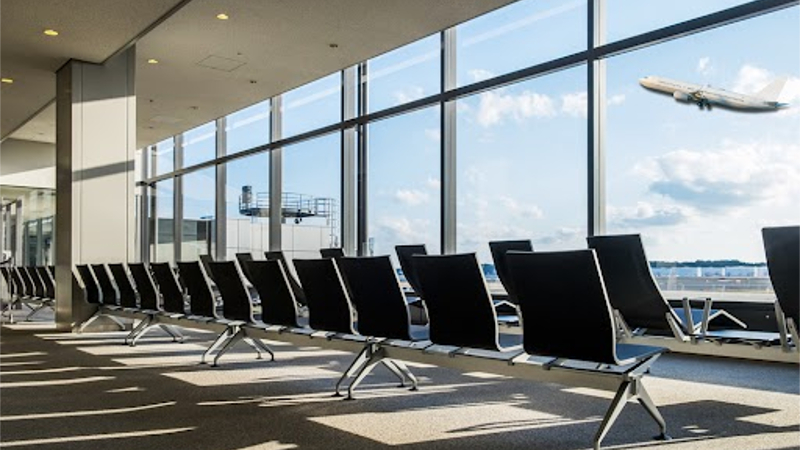
When planning a trip to Japan, make sure you know if there are any travel restrictions in place and any entry requirements you need to follow.
Japan has now completely removed all COVID-19 entry restrictions . Immigration rules have returned to normal from May 8, 2023 .
If you are thinking about traveling to Japan, you can check this regularly updated page and find out what you need to visit the country.
Below you’ll find information about the reinstatement of visa exemptions , vaccine and testing requirements, and other coronavirus measures in Japan.
Can I Travel to Japan Now?
Yes , Japan’s borders are now open to all international tourist travel.
You can easily travel to Japan by air or by sea as long as you meet the standard entry requirements.
Japan has completely removed the entry cap on daily foreign arrivals. All the usual visa exemptions currently apply to eligible visitors. This means that citizens of around 70 countries, including Australia, the United States and all European Union nations, can once again visit Japan for 90 days visa-free simply by using a valid passport.
Once in the country, train services are running as normal. You can use your Japan Rail Pass to travel around the nation at your leisure.
Japan Standard Entry Requirements
If you’re not a national of a visa-exempt country , you’ll need a visa to travel to Japan.
You should also make sure you have a valid passport , and other necessary documentation to enter the country.
If you have an e-Passport, you can use the Electronic Customs Declaration Gates (e-Gates) when arriving in Japan to clear border control.

Public transportation restrictions within Japan
Public transport, including trains, is operating in Japan. Travelers are advised to refer to Japanese train status updates issued by each individual operator to check if a service they plan to use remains affected by temporary Shinkansen COVID-19 restrictions.
Face masks are no longer required on JR trains or in most other places. They are still common and recommended, but are ultimately optional .
Who can travel to Japan now?
Anyone who meets the normal entry requirements can now travel to Japan.
All travelers should ensure they have a valid relevant visa for Japan (unless visa-exempt), a valid passport, and other necessary documentation to enter the country.
North Koreans cannot currently enter Japan due to sanctions. Apart from this, there are no other travel bans in place.
For further information about visas and visa exemptions, please check with the Japanese Ministry of Foreign Affairs at https://www.mofa.go.jp/ .
Rules for tourists
Individual tourists can now travel to Japan. There is no longer any need to book a place on a package tour.
Although mask use is not obligatory outdoors in Japan, it is still recommended in crowds or when having a conversation at close quarters.
Quarantine measures when traveling to Japan
There are currently no quarantine measures in Japan.
For further information, please check with the Japanese Ministry of Health at https://www.mhlw.go.jp/
Countries and regions banned to enter Japan
Only citizens of North Korea are currently prohibited from traveling to Japan. This is because the Japanese government has imposed sanctions on North Korea.
All other nationalities are allowed to visit Japan with the proper documentation. All travel bans due to coronavirus have now been lifted.
Travel advisories
Check the up-to-date travel advisories for Japan regarding COVID-19 from your country below:
- New Zealand
- United Kingdom
- United States
Health advice when visiting Japan
There are no specific health requirements in place for traveling to Japan.
Visitors are advised to have health insurance and be up-to-date on standard vaccinations. Recommended vaccines include:
- Chickenpox (Varicella)
- Diphtheria-Tetanus-Pertussis
- Flu (influenza)
- Hepatitis A
- Hepatitis B
- Japanese encephalitis
- Measles-Mumps-Rubella (MMR)
Japan’s Health Ministry has stated that the two most effective ways to curb the spread of illnesses like the coronavirus are to frequently wash hands and use a face mask when out in public:
- You should wash your hands with soap and water for at least 20 seconds, or use an alcohol-based hand sanitizer containing at least 60% alcohol.
- Face masks are recommended in public. The mask should cover your mouth, nose and chin, and be disposed of after a single-use.
If you are traveling to Japan with medication, make sure you bring copy of the prescription, a doctor’s note, and bring your medicine in the original container.
For the latest travel advisory and information about restrictions, please visit the Japan National Tourism Organization’s site .
The Japan National Tourism Organization has also set up a coronavirus hotline for tourist information available in 3 languages: English, Chinese, or Korean:
- From within Japan : 050 3816 2787
- If overseas : +81 50 3816 2787
Related posts
Related tours & activities.

Visa to Japan
Apply online for eVisa to Japan
Visa to Japan » Japan Visa Requirements » Japan transit visa requirements
Japan transit visa requirements
- Japan Consultant
- May 28, 2021
So, keep on reading, and we will describe what the transit visa is, how to prepare for it, the visa fees, and other important things to know before transiting via Japan.
Table of Contents
What is the Japan Transit Visa?
A Japan Transit Visa is a necessary document for foreign travelers who need to transit through Japan on their way to any final destination. The transit visa is a regular travel permit obtained at an Embassy or electronically using the new Japan e-Visa system.
A regular Japan Transit Visa costs about 700 Yen. However, you should remember that the cost may vary depending on the country you are applying from. The fees should be paid upon getting visa approval and visiting the Embassy to collect the issued document.
To put it into perspective, 700 Yen is less than 7 USD.
Who does not need a Japan Transit Visa?
- You can transit through Japan visa-free if you are a citizen from any of the following countries:
- However, if you are not from the above-listed countries and if you are planning to enter Japan and transit to another third country destination, you are required to have a Japan Transit Visa.
Please note! Countries that can currently visit Japan without a travel permit will most likely need to apply for a Japanese e-Visa once it’s completely in place. Check the requirements when planning your trip.
Can I transit through Japan with an e-Visa?
But if you are unable to get a Japan Transit Visa approved, you can still travel through an e visa and transit to another third country as well. These e visas are issued for 30 days and are valid for 3 months.
What do I need to prepare for a regular Japan transit visa?
When applying for a regular Japan visa, the list of required documents to prepare is quite extensive. To complete your paperwork, make sure to gather the following documents:
- A fully completed and signed application form
- A passport with a minimum validity of 6 months from the intended date of arrival in Japan. Make sure to check if your travel document has at least two blank pages.
- A valid travel permit for the country of your final destination (if it’s required)
- A cover letter with the details of why you travel to Japan
- Passport-size photographs taken at least six months back, in the following sizes: 4.5cm x 4.5cm. Your face should be clearly visible, the background should be, and the facial expression neutral.
- Full flight details of your arrival and departure dates, flight reservation number, etc.
- A written document describing your itinerary and plans for the upcoming trip.
- Proof of having sufficient funds to cover the expenses of the trip. (this can either be a bank statement, a tax return, or both)
Please note! Since arranging the above-listed documents may take a while, it’s best to start preparing for the application process a few weeks ahead of the planned trip.
As can be seen above, the transit visa Japan requirements may seem difficult to gather. Thus, make sure to check the next section that describes the Japanese e-Visa requirements for an effortless alternative.
What documents are required for the Japanese e-Visa?
As opposed to the long list of documents described in the previous section, applying for the Japanese e-Visa does not require you to prepare in such an extensive way.
All you need is:
- A passport that will stay valid for at least 6 months from the intended date of arrival in Japan
- An active email address (to be able to receive the approved e-Visa in PDF form)
- Access to any online payment method of choice (could be a credit/debit card, PayPal, PayU, and more)
Not only is the list of required documents elementary, but the whole application process is also effortless and does not require you to visit an Embassy!
How can I apply for a regular Japan transit visa?
The first point to notice is the fact that regular Japan transit visa applications need to be submitted to an Embassy or a Consulate. Thus, it’s essential to give yourself at least a few weeks to complete the whole process.
Collect the required paperwork and make sure all your documents have the appropriate validity/blank pages as needed.
Next, schedule a visit to an Embassy or Consulate and go submit the complete paperwork once you’re ready.
Please note! Some countries do not accept applications for individual travel, and therefore check with it as you will be required to apply through an accredited travel agency.
Lastly, your Japan transit visa will be issued and added to your travel document. You can now use it to travel to Japan within three months of the approval date.
How to apply for the Japanese e-Visa?
Japanese e-Visa can be obtained entirely online after following three simple steps. Grab your valid passport and any working device with an internet connection.
Spare a few minutes, either at home, during a break at work, or at any other point in your day, and follow these steps to submit a successful application online:
- Complete the application form – put your data in the application form, including your name, surname, birth date, nationality, passport and travel details, and more. Make sure everything is correct and does not contain any mistakes.
- Cover the fees – select any preferred online payment method and cover the fees of issuing your Japanese e-Visa.
- Check your email box – the approved e-Visa for Japan will be sent to your email box in the form of a PDF file.
The processing time for the electronic Japan visa is just 72 hours! Whereas the regular visa can take even 10 business days or more to be issued.
In which cases can I transit through Japan without a visa?
You can transit through Japan without a visa only if you meet the following conditions:
- You will not leave the designated airport’s transit area
- You have a booked flight that takes off within the same day as your arrival
- You have all of the relevant paperwork for the next country you are traveling to (e.g., a valid visa)
Final thoughts
Getting a Japan Transit Visa may seem like a difficult process at first. But with the required documents as listed above and the eligible criteria, your visa application will be approved in no time.
So, what are you waiting for? This is your chance to explore Japan and also other countries as well whether you are traveling for tourism or business purposes!
- Media & Industry
- Meetings & Events
- Select Language 简体中文 繁體中文(香港) 繁體中文(臺灣) India (English) Bahasa Indonesia 한국어 ภาษาไทย Tiếng Việt Singapore (English) Philippines (English) Malaysia (English) Australia/New Zealand (English) Français Deutsch Italiano Español United Kingdom (English) Nordic countries(English) Canada (English) Canada (Français) United States (English) Mexico (español) Português العربية Japan(日本語) Global (English)
- India (English)
- Bahasa Indonesia
- Singapore (English)
- Philippines (English)
- Malaysia (English)
- Australia/New Zealand (English)
- United Kingdom (English)
- Nordic countries(English)
- Canada (English)
- Canada (Français)
- United States (English)
- Mexico (español)
- Global (English)
- Fujiyoshida
- Shimonoseki
- Ishigaki Island
- Miyako Island
- Kerama Island
- Tokyo Island
- Koka & Shigaraki
- Hida Takayama
- Ginza, Nihonbashi
- Beppu & Yufuin (Onsen)
- Ginzan Onsen
- Nagasaki Islands

- Kumano Kodo
- Shikoku Karst
- Amami Oshima
- Hachimantai
- Omihachiman
- Aizuwakamatsu

- Diving in Japan
- Skiing in Japan
- Seasonal Flowers in Japan
- Sustainable Outdoors
- Off the Beaten Track in Japan
- Scenic Spots
- World Heritage
- Home Stays & Farm Stays

- Japanese Gardens
- Japanese Crafts
- Temple Stays
- Heritage Stays
- Festivals and Events
- Theater in Japan
- Japanese Tea Ceremony
- Cultural Experiences in Japan
- Culture in Japan

- Local Cuisine Eastern Japan
- Local Cuisine Western Japan
- Local Street Food
- Japan's Local Ekiben
- Japanese Whisky
- Vegetarian and Vegan Guide
- Sushi in Japan Guide
- Japanese Sake Breweries

- Art Museums
- Architecture
- Performing Arts
- Art Festivals
- Japanese Anime and Comics
- Japanese Ceramics
- Local Crafts

- Scenic Night Views
- Natural Wonders
- Theme Parks
- Samurai & Ninja
- Iconic Architecture

- Wellness Travel in Japan
- Japanese Ryokan Guide
- A Guide to Stargazing in Japan
- Relaxation in Japan
- Forest Bathing (Shinrin-yoku)

- Experiences in Japan
- Enjoy my Japan
- National Parks
- Japan's Local Treasures
- Japan Heritage
- Snow Like No Other
- Wonder Around Japan

- Visa Information
- Getting to Japan
- Airport Access
- COVID-19: Practical Information for Traveling to Japan
- Anime Tourism
- Countryside Stays
- Accessible Tourism
- Hokkaido Great Outdoors
- Scenic World Heritage in Tohoku
- Shikoku’s Nature and Traditions
- Southern Kyushu by Rail

- Traveling by Rail
- How to Travel by Train and Bus
- JR Rail Passes
- Scenic Railways
- Renting a Car
- Sustainable Travel in Japan
- Travel Brochures
- Useful Apps
- Online Reservation Sites
- Eco-friendly Accommodation
- Luxury Accommodations
- Traveling With a Disability
- Hands-free Travel
- How to Book a Certified Tour Guide
- Volunteer Guides
- Tourist Information Center

- Japanese Manners
- Spring in Japan
- Summer in Japan
- Autumn in Japan
- Winter in Japan
- Cherry Blossom Forecast
- Autumn Leaves Forecast

- Japan Visitor Hotline
- Travel Insurance in Japan
- Japan Safe Travel Information
- Accessibility in Japan
- Vegetarian Guide
- Muslim Travelers
- Safety Tips

- JAPAN Monthly Web Magazine
- Arts & Cultures
- Nature & Outdoor
- Festivals & Events
- Insider Blog
- Things to do
- Local Guides
- Food & drink
- Traditional
- Hokuriku Shinetsu

My Favorites
${v.desc | trunc(25)}
Planning a Trip to Japan?
Share your travel photos with us by hashtagging your images with #visitjapanjp
GUIDE How to travel by train and bus in Japan
- Stories & Guides
- How to travel by train and bus in Japan
When traveling throughout Japan, most visitors use public transport, such as trains, the shinkansen (bullet train), and buses.
The convenience of trains in japan.
In major cities, trains come every few minutes, while a little more planning is required in rural areas as services can be more limited. Japan's trains are known for always being on schedule, making it easy to plan your trips down to the minute.
You can save time traveling with a prepaid rechargeable transportation card. While different railway companies issue different cards, you can use most of them across various services and cities throughout Japan. Suica and PASMO are some of the most commonly used IC Cards in the Kanto area. Among other cards used, there is ICOCA and TOICA, depending on the area. However, depending on the IC card, you may only be able to use it in certain areas and with certain forms of transportation.
Getting a card is simple. All you have to do is purchase it from a ticket machine or counter that you will be able to find at most train stations. The deposit fee for most cards is 500 yen, and you can get your money back if you return the card to the ticket counter at the end of your stay. You can also purchase Welcome Suica, a deposit-free card for tourists at certain places in the Kanto area, which is valid for up to 28 days.
You can add money to your card at almost all train stations in Japan at the automatic ticket machines. You just need to insert your card into the machine, follow the instructions, select and insert the desired amount of money you'd like to add, and your card will come back out charged and ready to go. Another option is to get a mobile IC card (PASMO or Suica) on your smartphone and charge it using your phone's wallet. However, be aware that they may not work on all smartphones.
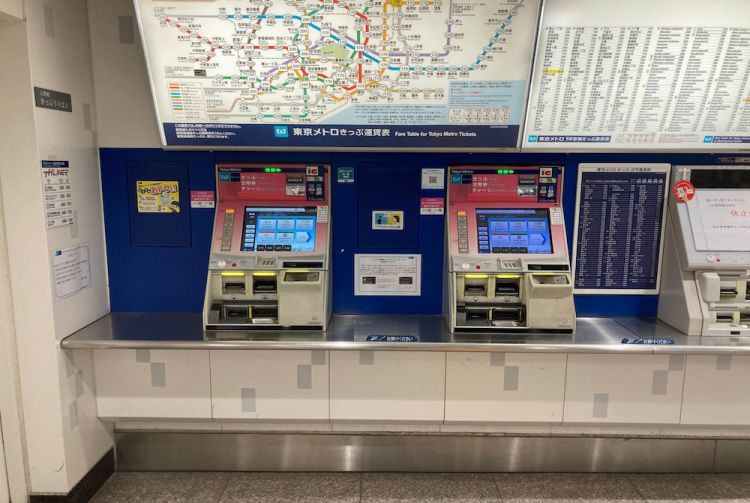
Some areas of Japan do not accept IC cards, as well as certain forms of transport, such as highway buses. Keep an eye out for the IC logo to see if you can use your card or not. A bonus of IC cards is that you can also use them to pay for items from many vending machines, stores, and lockers in train stations.
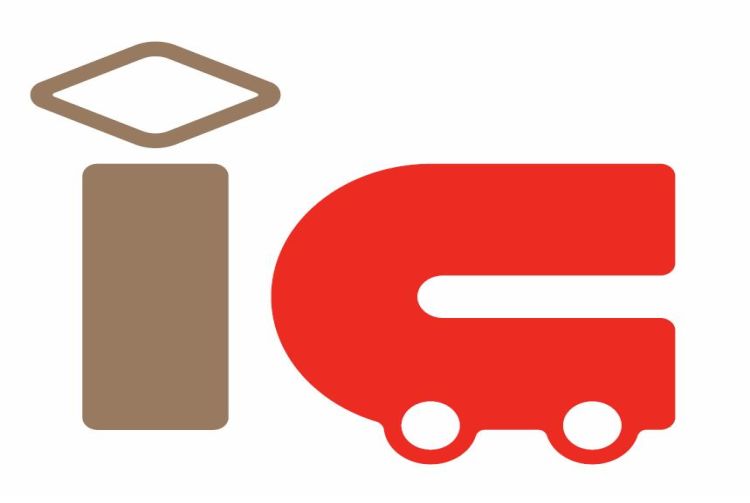
How to buy train tickets
As easy as IC cards are, tickets are also pretty straightforward. Even if you don't have an IC card, you can still buy tickets manually from machines at the station. The fares will differ depending on your destination, so be sure to check the fare chart at the station. Find out where you're going and how much it will cost, and buy a ticket accordingly.
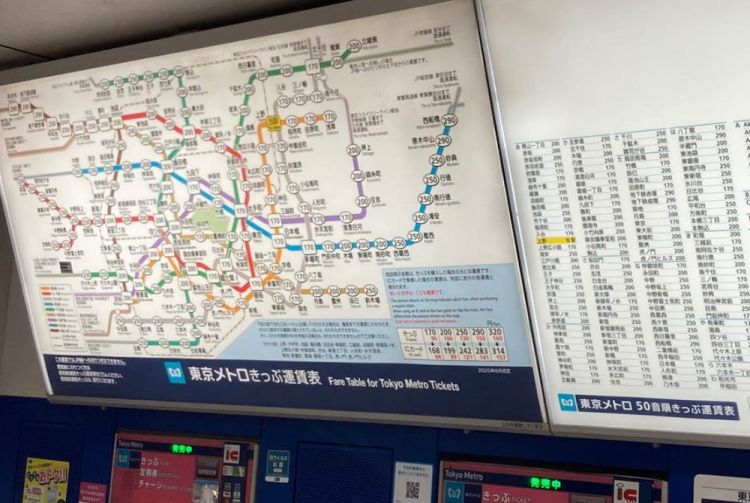
Be sure to look out for ticket deals, as one-day or weekend unlimited ride tickets are available from time to time.
How to take the train
Once you have your IC card or ticket, you'll need to know how to use it.
If you are using an IC card, tap it on the ticket gate to enter, and do the same again when you leave the gate at your destination. There may be the rare occasion when you tap your card and the gate won't open. This is likely because the reader either missed your card or your card funds are insufficient.
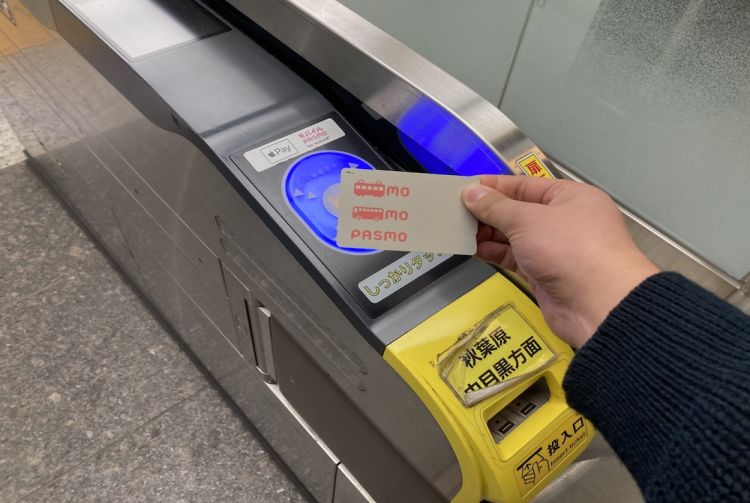
PASMO® Registered in JPO.
With a paper ticket, insert it in the slot at the ticket gate, and it will come out at the other side. Be sure to grab and hold onto it because you'll need to do this again to exit the ticket gate. However, the machine will collect your ticket this time around. You can take your ticket to a fare adjustment machine inside the ticket gate if you need to adjust the fare.
If you have any problems, you can always go to a staffed ticket gate, where an employee will be able to help you with any issues you have.
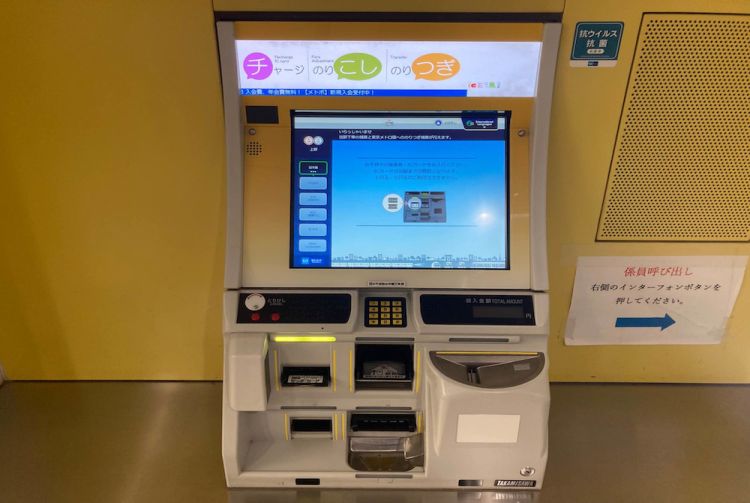
How to take the bus
You can check bus schedules with the apps mentioned above or read the timetable at the bus stops. The timetables show weekdays and weekends/holidays times. They will be written in 24-hour time with the hours on the left and minutes on the right.
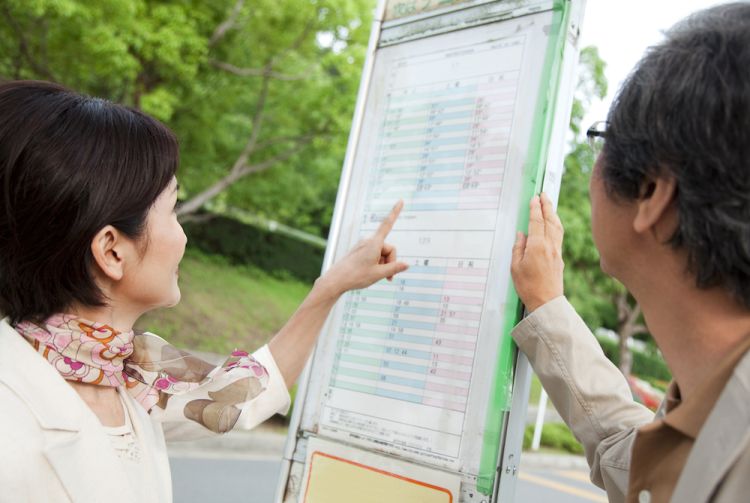
example of a timetable
There are two types of buses in Japan. For one of them, you will enter from the back, and it is a numbered ticket system instead of a flat rate system. You will exit from the front and pay your fare at the front that will differ depending on where you get on and off. On the other type of bus, you will enter from the front and pay a flat rate when you get on.
Not all buses accept IC cards, so be sure to check for the IC symbol at the bus stop or at the entrance of the bus when getting on. If there is no IC symbol, you will need to pay in cash. Luckily, most buses have easy-to-use exchange machines. If you plan on paying in cash, take a numbered ticket from the box when you get on the bus.(if it is a non-flat rate fare system). When you are approaching your stop, check the screen at the front of the bus and find your number along with the corresponding fare. As you get off the bus, put the exact fare in the machine at the front of the bus. If you put in more than your exact fare, you will not get any change back. However, if it is a flat rate system, when you get on at the front of the bus, even if you pay over, you will get change back in most cases.
In the case that you use your IC card, tap it once when you get on the bus, and tap it again when you get off the bus.
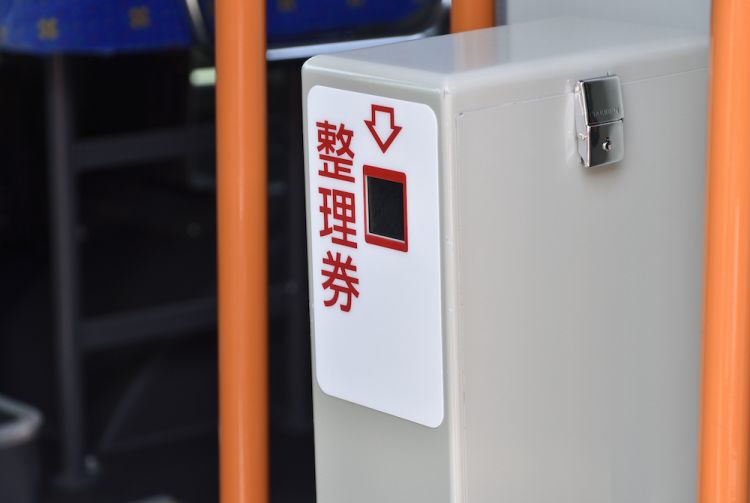
Take a numbered ticket from the box
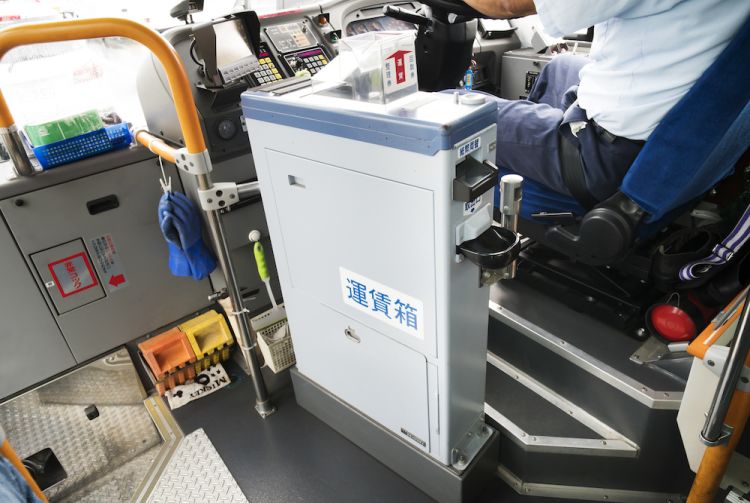
Put the fare in the machine or tap your IC card
Like anywhere in Japan, public transit is a place where you should exercise good manners.
One of the rules you should follow is that, if possible, refrain from talking on the phone while on the train. However, on a long-distance train such as the shinkansen, it is okay to use the corridor between cars for this. Other rules to follow include no smoking or vaping, taking your backpack off and carrying it by hand or putting it on the luggage rack so you don't bump into others, and giving your seat up in the priority seat area.
You'll often see certain cars that are reserved for women only during this morning rush hour.
Therefore, utilizing these manners shows respect in Japanese society and helps everything run more smoothly.
* The information on this page may be subject to change due to COVID-19.
- Story & Guide
Did this information help you?
out of found this information helpful.
Thank you for your feedback.
Recommended for you.
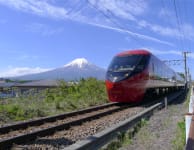
Please Choose Your Language
Browse the JNTO site in one of multiple languages
Tokyo: Getting there and around
How to get to tokyo.
By air - Tokyo has two airports: Narita Airport handles the majority of international flights and only a small number of domestic flights. It is located 60 kilometers outside of central Tokyo. The more centrally located Haneda Airport handles a smaller number of international flights and the majority of domestic flights.
By shinkansen - Most shinkansen lines lead to Tokyo. The trip from Osaka / Kyoto takes about three hours. There are also direct trains to/from Kyushu , Kanazawa , Niigata and various destinations in the Tohoku Region and Hokkaido .
Above fees and schedules are subject to change. Be sure to check current yen exchange rates .
Getting around
Tokyo is covered by a dense network of train , subway and bus lines, which are operated by about a dozen different companies. The train lines operated by JR East and the subway lines are most convenient for moving around central Tokyo.
Tokyo's most prominent train line is the JR Yamanote Line , a loop line which connects Tokyo's multiple city centers. The city's 13 subway lines are operated by two companies and run largely inside the Yamanote circle and the areas around Ginza and the area east of the loop line. Most of the many suburban train lines commence at one of the six major stations of the Yamanote Line (Tokyo, Ueno, Ikebukuro, Shinjuku, Shibuya and Shinagawa).
Major JR train lines in central Tokyo
The map shows Tokyo's major railway stations and the five JR lines that are most relevant to people who travel within central Tokyo.
- Yamanote Line Circle line that connects all major city centers.
- Keihin-Tohoku Line Runs parallel to the Yamanote Line on the eastern half of the circle.
- Chuo/Sobu Line (Local) Runs across the Yamanote circle (local slow service).
- Chuo Line (Rapid) Runs across the Yamanote circle (rapid service). Connects Tokyo Station with Shinjuku Station .
- Saikyo Line Runs parallel to the Yamanote Line on the western half of the circle. From Osaki Station, some trains continue running along the Rinkai Line in direction of Odaiba .
- Shinkansen Tokaido Shinkansen trains stop at Tokyo and Shinagawa , while bullet trains to the north stop at Tokyo and Ueno.
Tokyo's subway network is operated by two entities: Toei with four lines, and Tokyo Metro with nine lines. Together, they densely cover central Tokyo, especially the area inside the Yamanote circle and the areas around Ginza and the area east of the loop line.
Note, that at their terminal stations, the trains of some subway lines continue to operate on the tracks of different companies on suburban train lines. For example, the Chiyoda Subway Line is directly connected with the suburban Odakyu Line at Yoyogi-Uehara, and trains on the Fukutoshin Subway Line continue to run on the tracks of the Tokyu Toyoko Line at Shibuya.
Other railway companies
Besides JR East and the two subway companies, most other railway companies connect Tokyo with the metropolis' outer regions and surrounding prefectures . Their lines typically start at one of the stations of the JR Yamanote Line . Many of the private railway companies also operate department stores usually at their train lines' major stations.
- Tokyu Railway Serving southwestern Tokyo and Kanagawa .
- Tobu Railway Serving Saitama and Tochigi , including Nikko .
- Seibu Railway Serving the Tokyo Tama Region and Saitama .
- Keio Railway Serving the Tokyo Tama Region.
- Odakyu Railway Serving Kanagawa , including Hakone .
- Keisei Railway Serving Chiba , including Narita Airport .
- Keikyu Railway Serving Kanagawa , including Haneda Airport .
- Tsukuba Express Connecting Akihabara with Tsukuba City, Ibaraki .
Passes and Tickets
A whole variety of day passes is available for the Tokyo area, however, most of them are overpriced and/or not very practical because they do not cover all of Tokyo's train and subway lines. Consequently, single tickets or prepaid cards usually come cheaper, especially if you plan your city sightseeing in a geographically wise way.
Prepaid IC cards are generally the recommended way to get around Tokyo. Prepaid cards don't give you any discounts over single tickets, but they provide convenience as you can ride virtually any train or bus in Greater Tokyo (and most other major cities in Japan) with just a simple swipe over a card reader. They can also be used to make quick purchases at a large number of shops, restaurants and tourist spots across Japan.

Two types of IC cards are available for purchase in Tokyo: Suica cards at JR stations and Pasmo cards at non-JR stations. Furthermore, eight IC cards from other major cities of Japan can also be used on the trains and buses of Tokyo, including Icoca, Kitaca, Toica, Manaca, Pitapa, Sugoca, Nimoca and Hayakaken.
Only on days when you use trains or subways a lot, can it make sense to consider one of Tokyo's day passes:
- Tokyo Free Kippu (aka Tokyo Tour Ticket) (1600 yen) Unlimited use of all subway lines (Toei and Tokyo Metro ) and JR trains in the central Tokyo area on one calendar day (i.e. from the first to the last train of the day). It is also valid on buses and streetcars operated by Toei. The pass is overpriced and will unlikely provide any savings over regular tickets or prepaid cards.
- Tokyo Subway Ticket (24 hours: 800 yen, 48 hours: 1200 yen, 72 hours: 1500 yen) Unlimited use of all subway lines (Toei and Tokyo Metro ). Not valid on JR trains. The pass is sold at Narita Airport , Haneda Airport , ticket offices at some major subway stations, and selected Bic Camera and Yamada Denki electronic stores in central Tokyo to foreign tourists only (passport required). Furthermore, it is sold to both foreign tourists and residents of Japan through selected travel agencies and convenience stores outside of the Kanto Region . It can also be purchased online through Klook .
- Toei and Tokyo Metro One-Day Economy Pass (900 yen) Unlimited use of all subway lines (Toei and Tokyo Metro ) on one calendar day. The pass pays off only if you use the subways a lot. The pass is not valid on JR trains. Unlike the lower priced Tokyo Subway Ticket (see above), this pass can be purchased at the subway stations in central Tokyo.
- Tokyo Metro 24-Hour Ticket (600 yen) Unlimited use of the nine Tokyo Metro subway lines, but not the four Toei subway lines and JR trains. The ticket is available through ticket machines at Tokyo Metro stations.
- Toei One-Day Pass (Toei Marugoto Kippu) (700 yen) Unlimited use of the four Toei subway lines, buses and streetcars on one calendar day. It is not valid on the nine Tokyo Metro subway lines and JR trains. The pass is available at ticket machines and ticket counters at Toei stations.
- Tokunai Pass (760 yen) Unlimited use of JR trains in the central Tokyo area on one calendar day. The pass is available at the purple vending machines and ticket counters at JR stations.
The Japan Rail Pass and JR Tokyo Wide Pass are valid only on JR trains and the Tokyo Monorail. They cannot be used on subways or any other non-JR trains.
Questions? Ask in our forum .
Links and Resources
Tokyo metro, toei subway, odakyu electric railway, keio electric railway, keisei electric railway, keikyu electric railway, tokyu railway, tobu railway, seibu railway, tsukuba express, toei subways, odakyu railway, keio railway, keikyu railway, keisei railway, hotels around tokyo.

Experiences around Tokyo


COMMENTS
1.Undergo security screening after arrival Due to the difference in security screening criteria between Japan and other countries, passengers who have already been screened in the country of departure will be required to undergo screening again when transiting in Japan except for some cases. After getting off the airplane, proceed by following the "International Connecting Flights" guide sign ...
Travelers who are not entering Japan and transferring directly to a third country by transit, are not required to submit any documents and undergo inspections in Japan. Nonetheless, travelers are still subject to the travel/entry restrictions and requirements of their final destination.
Visas for U.S. citizens hoping to travel, study or work in Japan are controlled by the Japanese government. While the Japanese Government is the ultimate authority on visa matters, we include some general information on visas for U.S. citizens to aid in your planning.
The fee for a Japan Transit Visa is 700 Yen. You have to pay the fee at the Embassy or Consulate only if your visa application is approved. Keep in mind: The Japan visa cost may be slightly different based on your nationality, the type of visa you apply for and the local currency. If you apply through an approved travel/visa application agency ...
Get ready for your dream trip to Japan! From 11th October, tourists from all countries or regions can visit Japan with a valid vaccination certificate or a Covid-19 negative test certificate.
All coronavirus-related information on this website is gathered from the government ministries and authorities responsible for handling COVID-19 restrictions and measures. Due to the regularly changing situation and the constant updating of information, it is essential that you always check for updates and follow the latest guidance from the relevant ministries and official bodies.
9. Visit Japan Web. 10. Installation of apps and other requirements upon entry into Japan. All coronavirus-related information on this website is gathered from the government ministries and authorities responsible for handling COVID-19 restrictions and measures. Due to the regularly changing situation and the constant updating of information ...
When entering Japan, the first step after landing at the airport is getting through customs and immigration. Foreign visitors are required to complete various procedures upon arrival. Since the spread of Covid-19 in 2020, following procedures and rules is extremely important to ensure a safe trip! Here we will introduce what you need to prepare before a trip as well as entry procedures as of ...
Enroll in the Smart Traveler Enrollment Program (STEP) to receive security messages and make it easier to locate you in an emergency. Call us in Washington, D.C. at 1-888-407-4747 (toll-free in the United States and Canada) or 1-202-501-4444 (from all other countries) from 8:00 a.m. to 8:00 p.m., Eastern Standard Time, Monday through Friday ...
What do you need to bring to clear Japanese border control? Learn about the travel requirements and restrictions to visit Japan, including safety measures.
If you're planning a trip to Japan, here's what you'll need to know and expect if you want to visit during the global coronavirus pandemic.
Japan transit visa is yet another type of entry permit offered by the Japanese government to all eligible foreign travelers. But what does transit even mean? The process of transiting is when you're passing through an area to reach another one. Traveling to distant places is often connected with transiting and the need to have a layover in one country before reaching your final destination.
A Japan Transit Visa is a necessary document for foreign travelers who need to transit through Japan on their way to any final destination. The transit visa is a regular travel permit obtained at an Embassy or electronically using the new Japan e-Visa system.
The Importance of a Transit Visa A transit visa allows travelers to pass through Japan for a short duration, typically for less than 15 days.
When traveling throughout Japan, it is best to know how to use public transportation. Learn the ins and outs of traveling by train and bus.
Furthermore, it is sold to both foreign tourists and residents of Japan through selected travel agencies and convenience stores outside of the Kanto Region. It can also be purchased online through Klook. Toei and Tokyo Metro One-Day Economy Pass (900 yen) Unlimited use of all subway lines (Toei and Tokyo Metro) on one calendar day.
As the other answers suggest, you do not need a visa to transit at Narita, as stated by Timatic, the database used by airlines: Visa required, except for holders of onward tickets transiting on the same calendar day. Important to note, however, is that a transit visa is also not required for an overnight transfer (even though Narita's transit ...
If you are transiting Japan to an onward international destination, you will not be subject to Japanese entry requirements, as long as your transit occurs within the same airport and no overnight stay is required. You will not be permitted to travel from one Japanese airport to another in order to board a connecting flight. Please note that Narita Airport does not operate 24 hours and you will ...
1. Re: Transiting in Japan. Unless the immigration situation changes by then, you will not be able to transit in Japan to a non-connecting flight, even if you do not leave the airport. So if you are using two tickets for separate flights (where the final destination for the first one is Japan) then it is not possible.
The Danish Embassy in Japan has stated that transit in Japan has become kind of complicated. "You cannot travel with transit in Japan if you are traveling from a country from which entry to Japan is restricted [ED: hard to translate "indrejseforbud"] .
Airlines in Japan may deny you boarding for transit if you do not have the required travel documents for an onward destination in another country or if your passport does not have six months of validity remaining. For the entry requirements of the country you are traveling to, visit the State Department's Country Specific Information website.